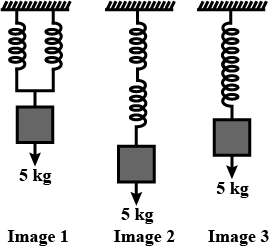
Two identical springs have the same force constant $ 73.5N{m^{ - 1}} $ . The elongation produced in each spring in three cases shown in figure (a), figure (b), and figure (c). ( $ g = 9.8m{s^{ - 2}} $ ):

(A) $ \dfrac{1}{6}m,\dfrac{2}{3}m,\dfrac{1}{3}m $
(B) $ \dfrac{1}{3}m,\dfrac{1}{3}m,\dfrac{1}{3}m $
(C) $ \dfrac{2}{3}m,\dfrac{1}{3}m,\dfrac{1}{6}m $
(D) $ \dfrac{1}{3}m,\dfrac{2}{3}m,\dfrac{2}{3}m $

Answer
513k+ views
Hint :Here, the spring constant is given and we have to find the elongation produced in each spring. To find elongation we have to find the resultant of each spring constant in each figure with weight hanging on the spring due to which elongation is possible.
Complete Step By Step Answer:
Here, the spring constant is $ 73.5N{m^{ - 1}} $ and let us denote it as $ k $ .
Now, let us first consider the figure (a), the effective spring constant is given by:
Let effective spring constant be $ {k_1} $
$ {k_1} = k + k $
$ \Rightarrow {k_1} = 2k = 2(73.5) = 147N{m^{ - 1}} $
In figure (a), the elongation in the spring, is given by
Let us consider elongation in figure (a) as $ {y_1} $
$ {y_1} = \dfrac{{mg}}{k} = \dfrac{{5 \times 9.8}}{{147}} = \dfrac{1}{3} $
$ \therefore {y_1} = \dfrac{1}{3}m $
Now, in figure (b), let us find the effective spring constant of the springs given in the above figure.
Let effective spring constant be $ {k_2} $ , it is given by:
$ {k_2} = \dfrac{{k \times k}}{{k + k}} = \dfrac{{{k^2}}}{{2k}} = \dfrac{k}{2} = \dfrac{{73.5}}{2}N{m^{ - 1}} $
The elongation of the spring be $ {y_2} $ in figure (b) as
$ {y_2} = \dfrac{{5 \times 9.8 \times 2}}{{73.5}} = \dfrac{2}{3} $
$ \therefore {y_2} = \dfrac{2}{3}m $
Now, in figure (c), the effective spring constant is as follows:
Let $ {k_3} $ be the effective spring constant in figure (c),
$ {k_3} = k = 73.5N{m^{ - 1}} $
The elongation of the spring be $ {y_3} $ in figure (c)
$ {y_3} = \dfrac{{5 \times 9.8}}{{73.5}} = \dfrac{2}{3}m $
$ \therefore {y_3} = \dfrac{2}{3}m $
Thus, we have concluded that the elongations in the figures with springs and given spring constant is as follows $ \dfrac{1}{3}m,\dfrac{2}{3}m,\dfrac{2}{3}m $ respectively.
The correct answer is option D.
Note :
Here, we have been given the spring constant of springs in the above figures using that we calculated the effective spring constant and found their elongations in each figure. The elongation is calculated by using formula $ {y_E}{\text{ }} = {\text{ }}{l_0}{\text{ }} + {\text{ }}\dfrac{{mg}}{k} $
Complete Step By Step Answer:
Here, the spring constant is $ 73.5N{m^{ - 1}} $ and let us denote it as $ k $ .
Now, let us first consider the figure (a), the effective spring constant is given by:
Let effective spring constant be $ {k_1} $
$ {k_1} = k + k $
$ \Rightarrow {k_1} = 2k = 2(73.5) = 147N{m^{ - 1}} $
In figure (a), the elongation in the spring, is given by
Let us consider elongation in figure (a) as $ {y_1} $
$ {y_1} = \dfrac{{mg}}{k} = \dfrac{{5 \times 9.8}}{{147}} = \dfrac{1}{3} $
$ \therefore {y_1} = \dfrac{1}{3}m $
Now, in figure (b), let us find the effective spring constant of the springs given in the above figure.
Let effective spring constant be $ {k_2} $ , it is given by:
$ {k_2} = \dfrac{{k \times k}}{{k + k}} = \dfrac{{{k^2}}}{{2k}} = \dfrac{k}{2} = \dfrac{{73.5}}{2}N{m^{ - 1}} $
The elongation of the spring be $ {y_2} $ in figure (b) as
$ {y_2} = \dfrac{{5 \times 9.8 \times 2}}{{73.5}} = \dfrac{2}{3} $
$ \therefore {y_2} = \dfrac{2}{3}m $
Now, in figure (c), the effective spring constant is as follows:
Let $ {k_3} $ be the effective spring constant in figure (c),
$ {k_3} = k = 73.5N{m^{ - 1}} $
The elongation of the spring be $ {y_3} $ in figure (c)
$ {y_3} = \dfrac{{5 \times 9.8}}{{73.5}} = \dfrac{2}{3}m $
$ \therefore {y_3} = \dfrac{2}{3}m $
Thus, we have concluded that the elongations in the figures with springs and given spring constant is as follows $ \dfrac{1}{3}m,\dfrac{2}{3}m,\dfrac{2}{3}m $ respectively.
The correct answer is option D.
Note :
Here, we have been given the spring constant of springs in the above figures using that we calculated the effective spring constant and found their elongations in each figure. The elongation is calculated by using formula $ {y_E}{\text{ }} = {\text{ }}{l_0}{\text{ }} + {\text{ }}\dfrac{{mg}}{k} $
Recently Updated Pages
Master Class 12 Economics: Engaging Questions & Answers for Success

Master Class 12 Maths: Engaging Questions & Answers for Success

Master Class 12 Biology: Engaging Questions & Answers for Success

Master Class 12 Physics: Engaging Questions & Answers for Success

Master Class 8 Maths: Engaging Questions & Answers for Success

Class 8 Question and Answer - Your Ultimate Solutions Guide

Trending doubts
What is meant by exothermic and endothermic reactions class 11 chemistry CBSE

Which animal has three hearts class 11 biology CBSE

10 examples of friction in our daily life

One Metric ton is equal to kg A 10000 B 1000 C 100 class 11 physics CBSE

1 Quintal is equal to a 110 kg b 10 kg c 100kg d 1000 class 11 physics CBSE

Difference Between Prokaryotic Cells and Eukaryotic Cells




